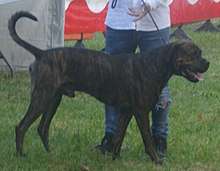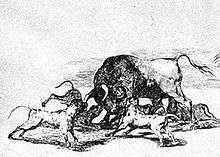Alano Español
The Alano Español or Spanish Alano is a Spanish breed of large dog of molossoid type. The dogs have been used as cattle catch dogs, hunting, and guarding.[4] It was formerly use during Spanish bullfights, and is sometimes called the Spanish Bulldog in English.
| Alano Español | |||||||||||||||||||||||||||
|---|---|---|---|---|---|---|---|---|---|---|---|---|---|---|---|---|---|---|---|---|---|---|---|---|---|---|---|
 | |||||||||||||||||||||||||||
| Other names | |||||||||||||||||||||||||||
| Origin | Spain | ||||||||||||||||||||||||||
| |||||||||||||||||||||||||||
| |||||||||||||||||||||||||||
| Notes | The Alano Español is recognised in Spanish legislation[3] | ||||||||||||||||||||||||||
| Dog (domestic dog) | |||||||||||||||||||||||||||
History
The name of the breed comes from the Iranian tribe of Alani, nomadic pastoralists who arrived in Spain as part of the Migration Period in the 5th Century. These peoples were known to keep large livestock guardian dogs and pursuit dogs which became the basis for the many regional Alaunt types. The first written reference to the breed in Spain is in a chapter of the 14th century "Book of the Hunt of Alfonso XI" (Libro de la Montería de Alfonso XI) in which hunting dogs called Alani are described as having beautiful colours.[5] Dogs of this type traveled with Spanish explorers and were used as war dogs (as was their role in Eurasia before migration) in the subjugation of Indian (Native American) peoples, as well as in the capturing of slaves.[6]

Bull-baiting, done in the bullfighting ring with dogs of this type, was recorded by Francisco de Goya in his series on La Tauromaquia in 1816.[7] It was outlawed in 1880.
In 1880, use of dogs in the bullfighting ring was outlawed,[8] so the breed numbers began to dwindle as the work they performed began to change. Big game became rare, stockyards were modernized and no longer needed dogs to hold the cattle, using dogs in bullfights was outlawed, and by 1963 Alanos were thought to be extinct.
Recognition
In the 1970s a group of fanciers and veterinary students made house-to-house calls in western and northern Spain. They found a few examples of the dogs in the Basque areas of Enkarterri and Cantabria that were being used to herd semi-wild cattle and hunt wild boar. A breed standard was written and the dogs were documented and bred.
In the early 1990s, breeders were involved in the recovery process of the small vulnerable population, and in 1995 the breeders organized into Asociación Nacional de Criadores de Alano Español (the National Association of Breeders of Spanish Alano).[9]
The Alano Español was recognised as an independent breed by Real Sociedad Canina de España (the Spanish Kennel Club) in 2004, and studies at the University of Cordoba clarified the Alano as distinct from any other breed at the genetic level. The Spanish Ministry of Agriculture (Ministerio de Agricultura, Pesca y Alimentación) recognises the Alano Español as an indigenous Spanish breed.
The breed in Spain is still small in number and the breed has not yet been recognised by the Fédération Cynologique Internationale. Examples of the Alano Español have been exported to North America where a few breeders are promoting it for its temperament and hunting ability.
Characteristics

The Alano Español is a very large dog of molossoid type, with a large, strong head. Males should be no smaller than 58 centimetres (23 in) at the withers, and should weigh 34–40 kilograms (75–88 lb) with females somewhat smaller.[10]
The coat is short and thick but never velvety, and is most often a brindle of any color; leonardo (fawn); black and brindle; sable wolf. White chest flashes are acceptable but prevalence of white is not. The face may or may not have a black mask.[11]
The head is the shape of a cube and is brachycephalic. The muzzle is short with the lower jaw slightly concave, and has a very large, broad, black nose. The ears are set high and may be drop or cut short. The skin is very thick, with neck folds and some wrinkles on the face.[11]
Despite the sometimes used English name, the Alano is not a bulldog: it should never have a flat muzzle or show signs of prognathism. The cranio-facial proportion should be 65:35, meaning a significantly longer muzzle than for instance the Boxer has.[12]
Since the breed was used for hunting in packs, it is sociable with other dogs.[8]
References
| Wikimedia Commons has media related to Alano Español. |
- The Bully Breeds by David Harris p92
- Canines in Cervantes and Velázquez: An Animal Studies Reading of Early Modern Spain by John Beusterien p62
- Royal Decree 558/2001 of May 25, p63
- "Alano Español". www.rsce.es. Real Sociedad Canina de España.
- Alano Español in El Mundo del Perro Magazine, retrieved 23/02/2009
- Derr, Mark (2004). A Dog's History of America. North Point Press. pp. 23–45. ISBN 978-0-86547-631-8. Lay summary.
- La Tauromaquia Archived 2008-05-17 at the Wayback Machine 25, "Echan perros al toro" They Loose Dogs on the Bull
- "Alano Español". El Mundo del Perro. 22 October 2014.
- "Welcome to the Official Website of ANCAE". Asociación Nacional de Criadores de Alano Español.
- "Así es el Alano Español, el perro que participó en la Conquista de América". abc (in Spanish). 2019-04-04. Retrieved 2019-08-06.
- "Spanish Alano Breed Standard" (PDF). Real Sociedad Canina de España. 17 October 2012. Retrieved 10 August 2019.
- Jarén Nebot, Manuel (2001). Alano Español (1 ed.). Torredonjimeno: Editorial Jabalcuz. p. 121. ISBN 84-95233-24-X.